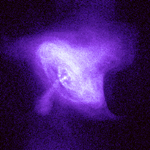September 28, 1999
CXC PR: 99-06
After barely two months in space, NASA's Chandra X-ray Observatory has taken a stunning image of the Crab Nebula, the spectacular remains of a stellar explosion, and has revealed something never seen before: a brilliant ring around the nebula's heart.
Combined with observations from the Hubble Space Telescope, the image provides important clues to the puzzle of how the cosmic "generator," a pulsing neutron star, energizes the nebula, which still glows brightly almost 1,000 years after the explosion.
"The inner ring is unique," said Professor Jeff Hester of Arizona State University, Tempe, AZ. "It has never been seen before, and it should tell us a lot about how the energy from the pulsar gets into the nebula. It's like finding the transmission lines between the power plant and the light bulb."
Professor Mal Ruderman of Columbia University, New York, NY, agreed. "The X-rays Chandra sees are the best tracer of where the energy is. With images such as these, we can directly diagnose what is going on."
What is going on, according to Dr. Martin Weisskopf, Chandra Project Scientist from NASA's Marshall Space Flight Center, Huntsville, AL, is awesome. "The Crab pulsar is accelerating particles up to the speed of light and flinging them out into interstellar space at an incredible rate."
The image shows tilted rings or waves of high-energy particles that appear to have been flung outward over the distance of a light year from the central star, and high-energy jets of particles blasting away from the neutron star in a direction perpendicular to the spiral.
Hubble Space Telescope images have shown moving knots and wisps around the neutron star, and previous X-ray images have shown the outer parts of the jet and hinted at the ring structure. With Chandra's exceptional resolution, the jet can be traced all the way in to the neutron star, and the ring pattern clearly appears. The image was made with Chandra's Advanced CCD Imaging Spectrometer and High Energy Transmission Grating.
The Crab Nebula, easily the most intensively studied object beyond our solar system, is the remnant of a star that was observed to explode in 1054 A.D. Chinese astronomers in that year reported a "guest star" that appeared suddenly and remained visible for weeks, even during daytime. From gamma-ray telescopes to radio telescopes, the Crab has been observed using virtually every astronomical instrument that could see that part of the sky.
Unraveling the mysteries of the Crab has proven to be the door to insight after insight into the workings of the universe. The Crab convincingly tied the origin of enigmatic "pulsars" to the stellar cataclysms known as supernovas. Observations of the expanding cloud of filaments in the Crab were instrumental in confirming the cosmic origin of the chemical elements from which planets (and people) are made.
The nebula is located 6,000 light years from Earth in the constellation Taurus. The Crab pulsar, which was discovered by radio astronomers in 1968, is a neutron star rotating 30 times per second. Neutron stars are formed in the seconds before a supernova explosion when gravity crushes the central core of the star to densities 50 trillion times that of lead and a diameter of only 12 miles.
Another consequence of the dramatic collapse is that neutron stars are rapidly rotating and highly magnetized. Like a gigantic cosmic generator, the rotating magnet generates 10 quadrillion volts of electricity, 30 million times that of a typical lightning bolt.
"It is an incredibly efficient generator," Ruderman explained. "More than ninety-five percent efficient. There's nothing like it on Earth."
Press: Fact SheetTo follow Chandra's progress, visit the Chandra News Web site at:
NASA's Marshall Space Flight Center manages the Chandra program. TRW, Inc., Redondo Beach, CA, is the prime contractor for the spacecraft. The Smithsonian's Chandra X-ray Center controls science and flight operations from Cambridge, MA.
High resolution digital versions of the X-ray image (300 dpi JPG, TIFF) and other information associated with this release are available on the Internet at:
An animation of a supernova explosion and the formation of a supernova remnant can be found at:
NASA TV on the web
MEDIA CONTACTS
Dr. Wallace Tucker
Chandra X-ray Observatory Center
Harvard-Smithsonian Center for Astrophysics, Cambridge, MA
Phone: 617-496-7998
http://chandra.harvard.edu
Tim Tyson
Marshall Space Flight Center, Huntsville, AL
Phone: 256-544-0994



